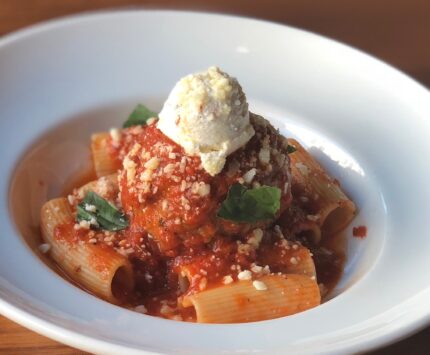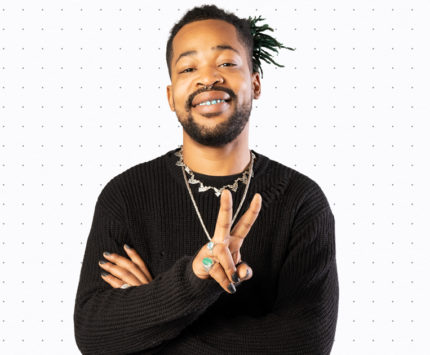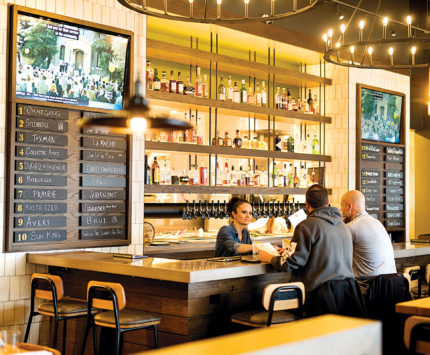Fruits of the Loop: An Unsung Milestone in Indy’s Downtown Development
The last unpoured segment of the I-65/I-70 inner loop in Indianapolis spanned only 6.64 miles, but its completion—40 years ago this month—was long on impact.
Not that it didn’t get a proper dedication. On October 15, 1976, Governor Otis Bowen and Mayor William Hudnut led the ribbon-cutting ceremony as hundreds of citizens looked on—some standing, some sitting in vehicles lined up for a first spin on the pristine pavement.
They thought it was a big deal, and they were right.
“This was a necessary step in the transformation of Indianapolis,” says Bill Benner, who spent 33 years as an Indianapolis Star sportswriter and now serves as the Indiana Pacers’ senior vice president of public relations. “If I had to think of two things that got Indianapolis moving forward—finally—the first would be Market Square Arena [built in 1974], and the second would be the completion of the inner loop, which made it much easier for people to come downtown at night.”
To fully appreciate Indy’s middle-aged expressway, imagine 65,000-plus NFL fans spilling out of Lucas Oil Stadium and heading home on the stoplight-laden likes of Meridian Street, Washington Street, Kentucky Avenue, and other prime thoroughfares of yesteryear. Or don’t imagine it—because without this key piece of infrastructure, there might never have been a Lucas Oil Stadium.
“It was a series of dominoes,” Benner recalls. “Without the interstate, it would have really held back downtown development. So maybe you don’t have the Hoosier Dome, or the Indianapolis Colts, or the Super Bowl. And maybe you don’t have Circle Centre or Victory Field.” Not to mention the synergistic array of hotels, restaurants, brewpubs, and other central-city offerings we now take for granted.
Nowadays, Indy touts its accessibility when competing for athletic championships, says Ryan Vaughn, president of the Indiana Sports Corp. “When sporting events choose Indianapolis, they know their fans can get here easily … right to their hotel room,” he says. And it doesn’t hurt Vaughn’s cause when CNBC’s “Top States for Business 2016” ranks Indiana No. 1 in infrastructure.
But even before its grand opening, the inner loop—31 miles of interstate within I-465, built at a cost of nearly $300 million—had begun paying downtown dividends. Real estate values around the superhighway increased in the early 1970s, reversing a 35-year decline, and Mayor Hudnut also credited the road with stimulating such projects as the Hilton Hotel, the Indiana National Bank building, and the $150 million expansion of Eli Lilly & Co.
Just three days after the ribbon-cutting, a Noblesville truck driver lost his life near the northeast interchange on a sharp bend where three other semis had already flipped. A graffiti artist labeled the spot “Dead Man’s Curve,” and the name stuck.
Hudnut predicted the new freeway would spur 20,000 new jobs, and state legislators embraced the spirit: In 1973, when a federal reimbursement slowdown threatened to add 10 years to its completion date, they fronted the money for the last leg of I-65/I-70. Truly, Indiana had reasserted its “Crossroads of America” status.
Or maybe a better term would have been “star-crossed,” at least when it came to the inner loop. Dubbed the Spaghetti Bowl for its complex network of lanes, ramps, and bridges, the road raised safety concerns almost before its white lines dried.
Just three days after the ribbon-cutting, a Noblesville truck driver lost his life near the northeast interchange on a sharp bend where three other semis had already flipped. A graffiti artist labeled the spot “Dead Man’s Curve,” and the name stuck—especially as the loop yielded eight more fatalities by October 1978. Local newspapers flung epithets like “killer highway,” while state officials employed a variety of fixes, including enhanced police patrols, reduced speed limits, extra signage, and a half-million-dollar improvement project that re-engineered Dead Man’s Curve.
But little relief awaited the neighborhoods that were carved up for the inner loop. The project displaced a total of 17,000 residents, including 6,000 from Fountain Square (one-fourth of the population).
Linda Osborne, owner of Arthur’s Music Store, remembers Fountain Square as a vibrant full-service community during the 1950s and early ’60s. “There were theaters, grocery stores, shoe stores—all the things you have in a small town,” says Osborne, whose family business opened in 1952. Interstate construction, however, dug a wide channel that isolated Fountain Square from downtown. Then as now, a Virginia Avenue bridge carried traffic over the chasm, but the commercial district soon tanked, Osborne says.
Such experiences helped doom a proposed I-69 extension to the loop, which gained federal approval in 1978. State legislators had no stomach for more wrecking-ball displacement, and I-69 continued to terminate at I-465 in Castleton.
Given the inner loop’s current traffic count of 150,000 vehicles per day (it was designed to handle 61,000), the decision not to extend I-69 remains debatable. But at least Indy got its downtown expressway built—something Fort Wayne opted out of in 1947 to avoid massive housing losses. Then, in the 1960s, brand-new I-69 swung wide of Fort Wayne and lured regional malls in the process, hastening the downfall of that city’s downtown.
All of which goes to show that while neighborhood preservation is desirable, sometimes—in the words of that great logician, Spock— “the needs of the many outweigh the needs of the few.”
Just don’t go searching for an Inner Loop Admiration Society in Fountain Square, where only in recent years have property values begun to skyrocket. “Looking at it today, I would say, ‘Yes, it’s an advantage,’” Osborne says of the interstate. “But it took 30 years to get to that advantage.”





